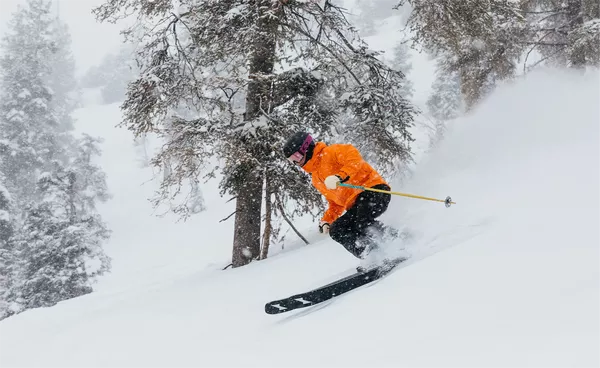When it comes to skiing, enthusiasts are often faced with a myriad of equipment options tailored to different terrains and styles. Among these choices, all-mountain skis stand out as a versatile and popular option for skiers who want to conquer various conditions with a single pair of skis. In this comprehensive guide, we’ll delve into what all-mountain skis are, their key features, how they differ from other types of skis, and why they’re a favorite among both recreational and advanced skiers.
Understanding All-Mountain Skis
All-mountain skis are designed to perform well across different types of snow and terrain, making them a go-to choice for skiers who enjoy exploring various parts of the mountain. These skis strike a balance between the characteristics of carving skis, which excel on groomed runs, and powder skis, which are optimized for deep snow and off-piste adventures.
The defining feature of all-mountain skis is their versatility. They typically have a moderate waist width, ranging from around 80mm to 100mm underfoot, allowing them to handle both groomed slopes and softer snow with ease. This waist width provides stability on hardpack while offering enough flotation in powder. The shape and construction of all-mountain skis vary, but they generally feature a blend of traits that make them adaptable to different conditions.
Key Features of All-Mountain Skis
Waist Width: As mentioned, all-mountain skis have a versatile waist width, which allows for effective performance across a range of snow conditions. A narrower waist provides better edge-to-edge quickness for groomed runs, while a wider waist enhances floatation in softer snow.
1. Rocker Profile: All-mountain skis often incorporate a rocker profile, which means the tips and tails are lifted off the snow. This feature helps with turn initiation and provides better float in powder, making them more maneuverable in variable terrain.
2. Flex: The flex of all-mountain skis is typically medium to stiff. This stiffness offers stability at higher speeds and when carving on hardpack, while still allowing for some forgiveness in softer snow.
3. Sidecut: The sidecut radius of all-mountain skis is moderate, allowing for versatile turning capabilities. This means they can carve on groomers and navigate through trees or bumps without feeling cumbersome.
4. Construction: Modern all-mountain skis often use advanced materials like carbon fiber, titanium, or various types of wood cores. These materials enhance performance, durability, and responsiveness.
How All-Mountain Skis Differ from Other Types
To appreciate the value of all-mountain skis, it’s important to understand how they compare to other ski types:
1. Carving Skis: Carving skis are narrower and more rigid, optimized for making precise turns on groomed slopes. They lack the floatation and versatility of all-mountain skis in deeper or variable snow conditions.
2. Powder Skis: Powder skis have a wider waist and more pronounced rocker, designed specifically for skiing in deep powder. While excellent in powder, they can be less agile on hardpack compared to all-mountain skis.
3. Freeride Skis: Freeride skis are similar to all-mountain skis but often have a wider waist and more aggressive features, catering to skiers who spend most of their time off-piste in varied conditions.
Why Choose All-Mountain Skis?
The appeal of all-mountain skis lies in their versatility and adaptability. Here are several reasons why skiers of all levels choose all-mountain skis:
1. One-Ski Quiver: All-mountain skis can serve as a versatile all-in-one solution, suitable for a wide range of conditions and terrain types. This versatility makes them ideal for skiers who prefer exploring different parts of the mountain without constantly switching skis.
2. Adaptability: From groomed runs to moguls, trees, and powder stashes, all-mountain skis can handle it all. Their ability to perform well in varied conditions makes them a dependable choice for skiers who want to be prepared for anything.
3. Skill Development: All-mountain skis are forgiving enough for intermediate skiers to enjoy while providing the performance characteristics that advanced skiers appreciate. They can help skiers develop their skills across different types of skiing.
4. Convenience: Owning a single pair of all-mountain skis simplifies logistics and reduces costs associated with owning multiple pairs of specialized skis.
How to Choose All-Mountain Skis
Selecting the right pair of all-mountain skis involves considering several factors:
1. Skill Level: Different skis are designed for different skill levels. Beginners may prefer softer flex and more forgiving skis, while advanced skiers may opt for stiffer, more aggressive models.
2. Terrain Preference: Consider where you ski most often. If you spend more time on groomers, you might lean towards narrower all-mountain skis. If you prefer off-piste adventures, wider skis with more rocker might be preferable.
3. Waist Width: Choose a waist width that matches your skiing style. Narrower waists (80-90mm) are better for groomed runs, while wider waists (90-100mm+) provide better performance in deeper snow.
4. Rocker Profile: Decide on the amount of rocker that suits your skiing style. More rocker enhances flotation in powder but can feel less stable on hardpack.
5. Flex and Construction: Consider the stiffness and construction materials based on your skiing ability and preferences for performance characteristics.
Conclusion
All-mountain skis represent a versatile and popular category of ski equipment that appeals to a broad range of skiers. Whether you’re cruising groomers, exploring backcountry bowls, or navigating through trees, all-mountain skis offer the adaptability and performance needed to tackle diverse conditions. By understanding their key features and how they differ from other types of skis, you can make an informed choice that enhances your skiing experience across a variety of terrains and snow conditions.

